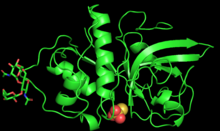| Zingibain | |||||||||
|---|---|---|---|---|---|---|---|---|---|
 PYMOL generated 3D structure of zingibain monomer | |||||||||
| Identifiers | |||||||||
| EC no. | 3.4.22.67 | ||||||||
| CAS no. | 246044-91-7 | ||||||||
| Databases | |||||||||
| IntEnz | IntEnz view | ||||||||
| BRENDA | BRENDA entry | ||||||||
| ExPASy | NiceZyme view | ||||||||
| KEGG | KEGG entry | ||||||||
| MetaCyc | metabolic pathway | ||||||||
| PRIAM | profile | ||||||||
| PDB structures | RCSB PDB PDBe PDBsum | ||||||||
| |||||||||
Zingibain, zingipain, or ginger protease (EC 3.4.22.67) is a cysteine protease enzyme found in ginger (Zingiber officinale) rhizomes.[1][2][3] It catalyses the preferential cleavage of peptides with a proline residue at the P2 position. It has two distinct forms, ginger protease I (GP-I) and ginger protease II (GP-II).[4]
As a member of the papain-like protease family of cysteine proteases, zingibain shares several structural and functional similarities with more well-studied enzymes such as papain, bromelain, and actinidin. These peptidases contain an active cysteine residue in their centers that catalyzes the hydrolytic cleavage of peptide bonds. Zingibain is noted for its activity as a proteinase and a collagenase.[1]
It was first isolated, purified, and reported in 1973 by Ichikawa et al. at Japan Women's University.[5] Recently, zingibain was found to exist as two isozymes, GP-I and GP-II, which were isolated by chromatography, with molecular weights of approximately 22,500 Da.[5]
- ^ a b Choi KH, Laursen RA (2000). "Amino-acid sequence and glycan structures of cysteine proteases with proline specificity from ginger rhizome Zingiber officinale". Eur. J. Biochem. 267 (5): 1516–26. doi:10.1046/j.1432-1327.2000.01152.x. PMID 10691991.
- ^ Ohtsuki K, Taguchi K, Sato K, et al. (1995). "Purification of ginger proteases by DEAE-Sepharose and isoelectric focusing". Biochimica et Biophysica Acta (BBA) - General Subjects. 1243 (2): 181–4. doi:10.1016/0304-4165(94)00145-n. PMID 7873561.
- ^ Choi KH, Laursen RA, Allen KN (1999). "The 2.1 A structure of a cysteine protease with proline specificity from ginger rhizome, Zingiber officinale". Biochemistry. 38 (36): 11624–33. doi:10.1021/bi990651b. PMID 10512617.
- ^ Huang XW, Chen LJ, Luo YB, et al. (2011). "Purification, characterization, and milk coagulating properties of ginger proteases". J. Dairy Sci. 94 (5): 2259–69. doi:10.3168/jds.2010-4024. PMID 21524515.
- ^ a b 喜美代, 道; 初世, 佐々; 芳江, 市川 (1973). "ショウガたん白分解酵素の分離精製". 栄養と食糧 (in Japanese). 26 (6): 377–383. doi:10.4327/jsnfs1949.26.377. ISSN 1883-8863.